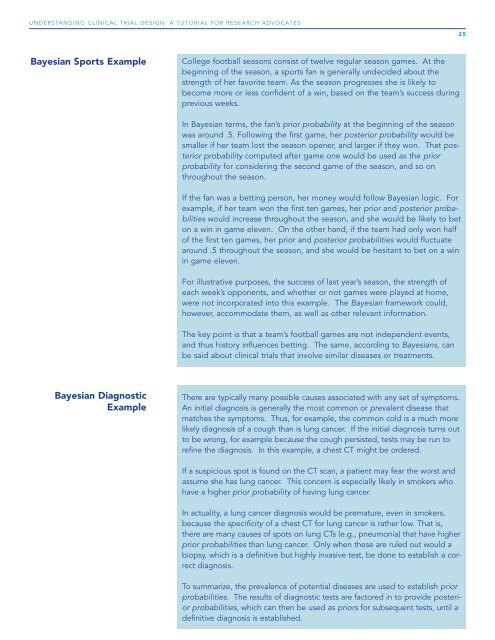Understanding Clinical Trial Design - Research Advocacy Network
Understanding Clinical Trial Design - Research Advocacy Network
Understanding Clinical Trial Design - Research Advocacy Network
You also want an ePaper? Increase the reach of your titles
YUMPU automatically turns print PDFs into web optimized ePapers that Google loves.
UNDERSTANDING CLINICAL TRIAL DESIGN: A TUTORIAL FOR RESEARCH ADVOCATES<br />
Bayesian Sports Example<br />
Bayesian Diagnostic<br />
Example<br />
College football seasons consist of twelve regular season games. At the<br />
beginning of the season, a sports fan is generally undecided about the<br />
strength of her favorite team. As the season progresses she is likely to<br />
become more or less confident of a win, based on the team’s success during<br />
previous weeks.<br />
In Bayesian terms, the fan’s prior probability at the beginning of the season<br />
was around .5. Following the first game, her posterior probability would be<br />
smaller if her team lost the season opener, and larger if they won. That posterior<br />
probability computed after game one would be used as the prior<br />
probability for considering the second game of the season, and so on<br />
throughout the season.<br />
If the fan was a betting person, her money would follow Bayesian logic. For<br />
example, if her team won the first ten games, her prior and posterior probabilities<br />
would increase throughout the season, and she would be likely to bet<br />
on a win in game eleven. On the other hand, if the team had only won half<br />
of the first ten games, her prior and posterior probabilities would fluctuate<br />
around .5 throughout the season, and she would be hesitant to bet on a win<br />
in game eleven.<br />
For illustrative purposes, the success of last year’s season, the strength of<br />
each week’s opponents, and whether or not games were played at home,<br />
were not incorporated into this example. The Bayesian framework could,<br />
however, accommodate them, as well as other relevant information.<br />
The key point is that a team’s football games are not independent events,<br />
and thus history influences betting. The same, according to Bayesians, can<br />
be said about clinical trials that involve similar diseases or treatments.<br />
There are typically many possible causes associated with any set of symptoms.<br />
An initial diagnosis is generally the most common or prevalent disease that<br />
matches the symptoms. Thus, for example, the common cold is a much more<br />
likely diagnosis of a cough than is lung cancer. If the initial diagnosis turns out<br />
to be wrong, for example because the cough persisted, tests may be run to<br />
refine the diagnosis. In this example, a chest CT might be ordered.<br />
If a suspicious spot is found on the CT scan, a patient may fear the worst and<br />
assume she has lung cancer. This concern is especially likely in smokers who<br />
have a higher prior probability of having lung cancer.<br />
In actuality, a lung cancer diagnosis would be premature, even in smokers,<br />
because the specificity of a chest CT for lung cancer is rather low. That is,<br />
there are many causes of spots on lung CTs (e.g., pneumonia) that have higher<br />
prior probabilities than lung cancer. Only when these are ruled out would a<br />
biopsy, which is a definitive but highly invasive test, be done to establish a correct<br />
diagnosis.<br />
To summarize, the prevalence of potential diseases are used to establish prior<br />
probabilities. The results of diagnostic tests are factored in to provide posterior<br />
probabilities, which can then be used as priors for subsequent tests, until a<br />
definitive diagnosis is established.<br />
25


